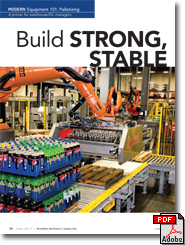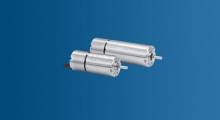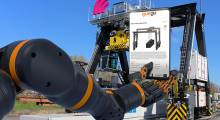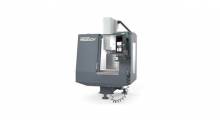Strong, stable, secure. These are important qualities in a palletized load. While palletizing is the science of placing and securing units or containers on pallets, it can be somewhat of a materials handling art form.
“If product is going to move, it has to be in an easy to handle unit load,” says Fred Hayes, director of technical services for the Packaging Machinery Manufacturers Institute (PMMI). “If it’s not on a pallet, it’s not going to go very far,” Hayes adds.
Of course, product is moving all the time and often has to go very far before reaching its destination. But getting it there is only half the battle; the other half is getting it to the final consumer in an appealing, salable condition. Enter palletizing equipment.
From basic assist equipment that works in manual operations to sophisticated robotic technology, here’s a look at a few palletizing solutions.
Manual palletizing
Manual palletizing can be done by people and without any mechanical assistance at all. However, there are simple solutions that can aid in the process.
Backboard: Since product placement on a pallet is important to the load’s structure, a backboard can be used to guide the loading process. Typically about 4 feet long and 6 feet high, a backboard is made of steel and welded together in a 90 degree angle, explains Dan Johnson, product line manager for palletizing for Brenton, a division of Pro Mach. It’s a simple alignment aid that means workers spend less time lining up the product as they build the load, he adds.
Lift assist and positioning: Manual palletizing can also be facilitated with assist devices like powered lift tables or work positioners that are specifically designed for palletizing functions.
Using calibrated springs or pneumatic devices, pallet positioners automatically adjust the height of the pallet load. Pallet positioners can be topped with turntables so that operators can stay in one place and rotate the load rather than waste time and steps walking around to build the pallet.
In some palletizing stations, when a pallet layer is complete, the operator lowers the work surface as required to maintain a comfortable working height.
Because positioners can hold up to 4,500 pounds, lift trucks are required for depositing and retrieving pallets.
Semi-automatic palletizers
There are physical and ergonomic challenges when you are palletizing manually. In addition, it’s difficult to attract and retain enough labor to keep an operation moving smoothly. Semi-automatic or automatic palletizing, with machines or robots, can eliminate the risk of ergonomic injuries to workers and reduce operator error.
Semi-automatic palletizing equipment, which is popular in niche markets where products are heavy and difficult to palletize manually, can handle up to 20 bags or cases per minute. This equipment is well suited for low-speed operations that can’t justify the cost of full automation but require a solution to help prevent worker injury.
In one style of a semi-automatic palletizer, a conveyor delivers product to an operator who arranges it into a layer on a plate. Then, with the press of a button, the plate surface retracts, allowing the layer of items to drop onto the pallet just below. The plate can be made of smooth metal, slippery polyethylene, rollers or even an air table for especially heavy products.
In another example, an operator receives product on a conveyor at an ergonomic workstation. A mixed-case pallet is built on a lift that the operator lowers as required to maintain a comfortable working height, explains Ken Ruehrdanz, warehousing and distribution market manager for Dematic.
Automatic palletizers
Fully automatic palletizing machines are the most ergonomic, fastest and most efficient type of palletizing equipment. They are also the most expensive, with costs depending on the speed of the machine and the sophistication of the accumulators, conveyors, pallet dispensers and other ancillary machinery needed to perform the total palletizing process.
Two types of automatic palletizers are available: conventional and robotic.
Conventional
Conventional palletizers are a good choice for many operations, says Jason Bennett, director of sales and marketing for vonGAL. That is because they cost less than a robotic machine and have a broader range of speeds, anywhere from 10 to 200 cases per minute.
There are several conventional palletizers on the market, including high- and low-level varieties, with the basic difference being where product is fed into the machine.
Low level: Low-level machines receive product from the floor level and are usually put right in packaging area where product comes downstream from the case packing equipment and is ready to be palletized.
High level: High-level palletizers receive product that is already available at ceiling level or use incline or spiral conveyor to elevate product to the right height. The machine forms a layer of products on a plate, it positions the plate above the pallet, and then it retracts the plate, letting the layer descend onto the pallet. “It’s like the old tablecloth trick where you pull the cloth out and leave the dishes behind,” says Pat O’Connor, product manager for palletizing systems at Intelligrated.
The machines repeat the cycle, sometimes changing the product placement pattern, until the load is complete. The varied patterned layers make a stronger unit load.
“Almost all conventional palletizers on market will come with a pattern utility or offer it as an option,” says O’Connor. “You can create new patterns right at the operator interface, which makes a conventional palletizer very flexible.”
Robotic
Robotic palletizing has been coming on strong in low- to medium-speed operations.
While the initial investment in equipment is higher, robotic palletizing solutions can save you money by reducing your labor costs and inventory expenses, and increasing availability and throughput.
Robotic systems can also offer several advantages over conventional machines. Pick-and-place robotic palletizers often have a smaller footprint, and they can simultaneously build multiple pallets from multiple product lines.
Robotic speeds are measured according to how many cycles per minute they perform.
“The only way to accommodate the higher throughput rates is to pick multiple cases at a time,” says John Schwan, director of sales and marketing for QComp Technologies.
Articulated arm: Most robotic palletizing systems use a jointed, or articulated, arm to pick products from an infeed conveyor and place them on a pallet. The arms are typically a four- or six-axis configuration, with each axis providing a point of movement. With this type, the machine stays still and the products move.
Gantry: With gantry style robotic palletizers, the opposite happens—products stay still while an overhead bridge crane moves back and forth, picks up product and places it in the designated location. Spanning about 150 feet, a multi-gantry system can pick 300 concurrent SKUs at more than 250,000 cases per day.
Robotic gantry systems eliminate 100% of the labor involved with building a mixed SKU pallet. “For safety reasons, you can’t have people in a robotic cell because of the unexpected motion of the robot,” explains Brian Keiger, technology sales leader of supply chain logistics at KUKA. “The motions are logical to robot, but not to the operator. The area is surrounded by an 8-foot fence with conveyor getting pallets in and full loads out without operator involvement.”
End effectors: Robot end-of-arm tools, or end effectors, that manipulate product can include heavy-duty claws for high-speed bag palletizing, vacuum grippers for light and medium weight cases, and clamp grippers for handling heavy cases.
In one example, an end-of-arm tool on the robot consists of fingers which support the product as well as a clamp mechanism which holds the product during the robot move. The fingers of the tool are inserted under the carton products and lifted then the clamp mechanism is activated to hold the products. When the layer is positioned over the placement location the fingers are pulled out from under the cartons and they drop slightly onto the stack. The clamp acts as a support while the fingers are stripped out from under the cartons.
In another end-of-arm tooling example, a head comes down and covers the entire area of the product, rollers inside the head engage the product at the bottom and use friction rollers to lift it up and move it.
About the Author
Follow Robotics 24/7 on Linkedin
Article topics
Email Sign Up
















